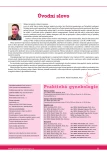Postcoital contraception up to date
Authors:
S. Pánková; R. Hudeček
Authors‘ workplace:
Gynekologicko-porodnická klinika, LF MU a FN Brno
Published in:
Prakt Gyn 2011; 15(2): 84-86
Category:
Review Article
Overview
Postcoital contraception includes the methods used to prevent inception after unprotected intercourse, after rape or in case of failure of another contraception method. Interception methods may be applied in the period from an unprotected intercourse until implantation. The paper provides a comprehensive overview of hormonal and invasive methods available for postcoital contraception. Hormonal tablets may be administered up to 120 hours post-coitus. The YUZPE method is described and the use of ESCAPELLE®, POSTINOR-2®, ELLAONE® is discussed. Invasive interception methods involve an application of an intrauterine device (IUD) up to 120 hours post-coitus. Prophylactic administration of antibiotics during the procedure and rigorous observation of aseptic method of insertion are advisable. When selecting a method of postcoital contraception, the time interval from unprotected intercourse until an application of the method and patient age and parity need to be considered. Non-invasive hormonal contraception is the method of choice. The patient has to be advised on possible adverse effects of this method. The reliability of this method increases with the decreasing time after intercourse. A description of the adverse effects associated with the selected product, possibility to repeat postcoital contraception and information on the risk of failure should be included in an informed consent with the use of interception. The use of a non-invasive interception method does not represent an increased risk for the foetus if the patient becomes pregnant. Failure of postcoital contraception does not represent an indication for a medical termination of pregnancy. Despite the wide options for use, postcoital contraception cannot provide a general substitution for contraception.
Key words:
interception – prevention of inception – methods – undesirable effects
Sources
1. Kovář P. Postkoitální antikoncepce a potratová pilulka. Lék Listy 2011; 1–2: 3.
2. Líbalová Z. Doporučení k předpisu postkoitální kontracepce. Mod Gynek Porod 2007; 16 (Suppl 1): 122.
3. Calda P. Levonorgestrel pohotovostní antikoncepce. Mod Gynek Porod 2022; 11 (Suppl B): 1.
4. Kolařík D, Halaška M, Feyereisl J. Repetitorium gynekologie. Praha: Maxdorf 2008.
5. Ellertson C, Trussell J, Stewart F et al. Emergency contraception. Semin Reprod Med 2001; 19(4): 323–330.
Labels
Paediatric gynaecology Gynaecology and obstetrics Reproduction medicineArticle was published in
Practical Gynecology

2011 Issue 2
Most read in this issue
- GyneFix – a frameless intrauterine device
- Pharmacotherapy of endometriosis in reproductive gynaecology
- The prognostic value of the SCCA tumour marker in patients surgically treated for squamous cell cervical cancer
- Probiotics in gynaecology
